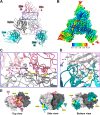Discovery of three novel neutralizing antibody epitopes on the human astrovirus capsid spike and mechanistic insights into virus neutralization
- PMID: 39846739
- PMCID: PMC11852706
- DOI: 10.1128/jvi.01619-24
Discovery of three novel neutralizing antibody epitopes on the human astrovirus capsid spike and mechanistic insights into virus neutralization
Abstract
Human astroviruses (HAstVs) are a leading cause of viral childhood diarrhea that infects nearly every individual during their lifetime. Although human astroviruses are highly prevalent, no approved vaccine currently exists. Antibody responses appear to play an important role in protection from HAstV infection; however, knowledge about the neutralizing epitope landscape is lacking, as only three neutralizing antibody epitopes have previously been determined. Here, we structurally define the epitopes of three uncharacterized HAstV-neutralizing monoclonal antibodies: antibody 4B6 with X-ray crystallography to 2.67 Å, and antibodies 3H4 and 3B4 simultaneously with single-particle cryogenic-electron microscopy to 3.33 Å. We assess the epitope locations relative to conserved regions on the capsid spike and find that while antibodies 4B6 and 3B4 target the upper variable loop regions of the HAstV spike protein, antibody 3H4 targets a novel region near the base of the spike that is more conserved. Additionally, we found that all three antibodies bind with high affinity, and they compete with receptor FcRn binding to the capsid spike. These studies inform which regions of the HAstV capsid can be targeted by monoclonal antibody therapies and could aid in rational vaccine design.IMPORTANCEHuman astroviruses (HAstVs) infect nearly every child in the world, causing diarrhea, vomiting, and fever. Despite the prevalence of human astroviruses, little is known about how antibodies block virus infection. Here, we determined high-resolution structures of the astrovirus capsid protein in a complex with three virus-neutralizing antibodies. The antibodies bind distinct sites on the capsid spike domain. The antibodies block virus attachment to human cells and prevent capsid spike interaction with the human neonatal Fc receptor. These findings support the use of the human astrovirus capsid spike as an antigen in a vaccine to prevent astrovirus disease.
Keywords: X-ray crystallography; capsid; cryo-EM; human astrovirus; monoclonal antibodies; neutralization; protein structure-function; surface antigens.
Conflict of interest statement
The authors declare no conflict of interest.
Figures







Update of
-
Discovery of three novel neutralizing antibody epitopes on the human astrovirus capsid spike and mechanistic insights into virus neutralization.bioRxiv [Preprint]. 2024 Sep 14:2024.09.14.613010. doi: 10.1101/2024.09.14.613010. bioRxiv. 2024. Update in: J Virol. 2025 Feb 25;99(2):e0161924. doi: 10.1128/jvi.01619-24. PMID: 39314284 Free PMC article. Updated. Preprint.
Similar articles
-
Discovery of three novel neutralizing antibody epitopes on the human astrovirus capsid spike and mechanistic insights into virus neutralization.bioRxiv [Preprint]. 2024 Sep 14:2024.09.14.613010. doi: 10.1101/2024.09.14.613010. bioRxiv. 2024. Update in: J Virol. 2025 Feb 25;99(2):e0161924. doi: 10.1128/jvi.01619-24. PMID: 39314284 Free PMC article. Updated. Preprint.
-
Structures of Two Human Astrovirus Capsid/Neutralizing Antibody Complexes Reveal Distinct Epitopes and Inhibition of Virus Attachment to Cells.J Virol. 2022 Jan 12;96(1):e0141521. doi: 10.1128/JVI.01415-21. Epub 2021 Oct 6. J Virol. 2022. PMID: 34613806 Free PMC article.
-
Structure of a Human Astrovirus Capsid-Antibody Complex and Mechanistic Insights into Virus Neutralization.J Virol. 2017 Jan 3;91(2):e01859-16. doi: 10.1128/JVI.01859-16. Print 2017 Jan 15. J Virol. 2017. PMID: 27807234 Free PMC article.
-
The Astrovirus Capsid: A Review.Viruses. 2017 Jan 19;9(1):15. doi: 10.3390/v9010015. Viruses. 2017. PMID: 28106836 Free PMC article. Review.
-
Parvovirus Capsid-Antibody Complex Structures Reveal Conservation of Antigenic Epitopes Across the Family.Viral Immunol. 2021 Jan-Feb;34(1):3-17. doi: 10.1089/vim.2020.0022. Epub 2020 Apr 21. Viral Immunol. 2021. PMID: 32315582 Free PMC article. Review.
Cited by
-
Functional characterization of DPP4 and FcRn as receptor and coreceptor for classical human astroviruses in Caco-2 cells.PLoS Pathog. 2025 Jul 18;21(7):e1013316. doi: 10.1371/journal.ppat.1013316. eCollection 2025 Jul. PLoS Pathog. 2025. PMID: 40680075 Free PMC article.
References
-
- Ghosh S, Kumar M, Santiana M, Mishra A, Zhang M, Labayo H, Chibly AM, Nakamura H, Tanaka T, Henderson W, Lewis E, Voss O, Su Y, Belkaid Y, Chiorini JA, Hoffman MP, Altan-Bonnet N. 2022. Enteric viruses replicate in salivary glands and infect through saliva. Nature New Biol 607:345–350. doi:10.1038/s41586-022-04895-8 - DOI - PMC - PubMed
MeSH terms
Substances
Grants and funding
LinkOut - more resources
Full Text Sources
Molecular Biology Databases

